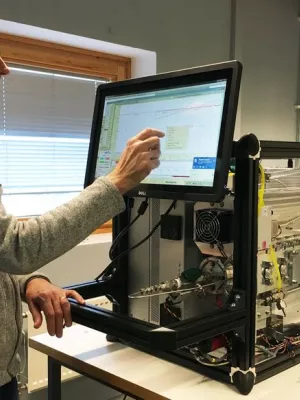
Erik Swietlicki
Professor

Extending the scope of dispersive liquid–liquid microextraction for trace analysis of 3-methyl-1,2,3-butanetricarboxylic acid in atmospheric aerosols leading to the discovery of iron(III) complexes
Author
Summary, in English
3-Methyl-1,2,3-butanetricarboxylic acid (MBTCA) is a secondary organic aerosol and can be used as a unique emission marker of biogenic emissions of monoterpenes. Seasonal variations and differences in vegetation cover around the world may lead to low atmospheric MBTCA concentrations, in many cases too low to be measured. Hence, an important tool to quantify the contribution of terrestrial vegetation to the loading of secondary organic aerosol may be compromised. To meet this challenge, a dispersive liquid–liquid microextraction (DLLME) method, known for the extraction of hydrophobic compounds, was extended to the extraction of polar organic compounds like MBTCA without compromising the efficiency of the method. The extraction solvent was fine-tuned using tri-n-octyl phosphine oxide as additive. A multivariate experimental design was applied for deeper understanding of significant variables and interactions between them. The optimum extraction conditions included 1-octanol with 15% tri-n-octyl phosphine oxide (w/w) as extraction solvent, methanol as dispersive solvent, 25% NaCl dissolved in 5 mL sample (w/w) acidified to pH 2 using HNO
3
, and extraction time of 15 min. A limit of detection of 0.12 pg/m
3
in air was achieved. Furthermore, unique complexation behavior of MBTCA with iron(III) was found when analyzed with ultra-high-performance liquid chromatography coupled with electrospray ionization–quadrupole time-of-flight mass spectrometry (UHPLC–ESI–QToF). A comprehensive overview of this complexation behavior of MBTCA was examined with systematically designed experiments. This newly discovered behavior of MBTCA will be of interest for further research on organometallic photooxidation chemistry of atmospheric aerosols. [Figure not available: see fulltext.].
Department/s
- Centre for Analysis and Synthesis
- MERGE: ModElling the Regional and Global Earth system
- Nuclear physics
- NanoLund: Centre for Nanoscience
Publishing year
2019-04-01
Language
English
Pages
2937-2944
Publication/Series
Analytical and Bioanalytical Chemistry
Volume
411
Issue
13
Document type
Journal article
Publisher
Springer
Topic
- Analytical Chemistry
Keywords
- Biogenic secondary organic aerosol
- Dispersive liquid–liquid microextraction
- MBTCA
- Metal complexes
- Trace analysis
Status
Published
ISBN/ISSN/Other
- ISSN: 1618-2642